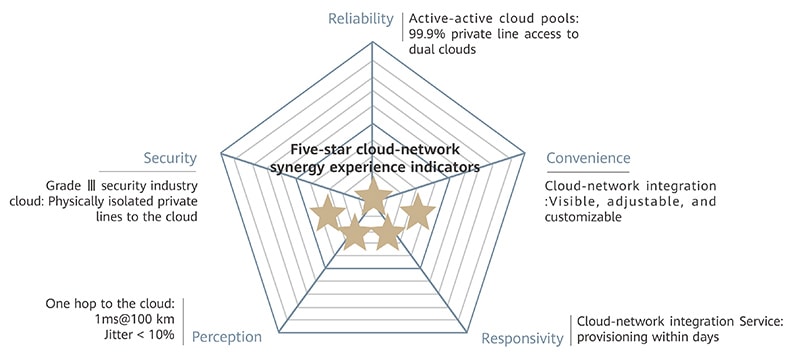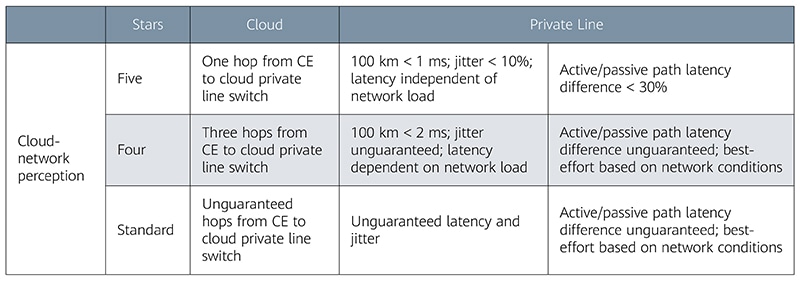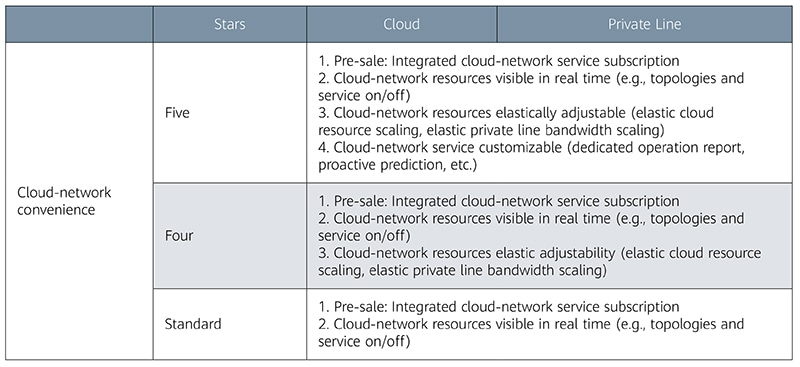Industry Trends
Premium OTN: Making Cloud Access Easy for Enterprises
Five cloud-network experience indicators can help guide enterprises on their cloud migration journeys.


By Liu Xiaoni, Optical Architecture & Technology Planning Dept, Optical Business Product Line, Huawei

The pandemic greatly impacted traditional industries, but it’s also created new opportunities for those same industries thanks to new business models and ways of working alongside the contactless economy and remote education and healthcare. However, enterprises need to migrate their production systems and core systems to cloud to achieve rapid development.
Easy access to high-quality cloud
Gartner predicts that by 2025, more than 85% of enterprise applications worldwide will have migrated to cloud, which will increase the value of the global cloud computing market to an estimated US$350 billion.
According to the White Paper on the Development of Cloud Computing (2020) published by China Academy of Information and Communications Technology, the private cloud market in China was worth 79.1 billion yuan (US$12.37 billion) in 2020, 22.6% higher than it was in 2019. This market is expected to continue to grow steadily in the next few years and reach 150 billion yuan by 2023.
Easy migration and access to high-quality, secure, and reliable cloud is a key requirement of enterprises.
High-quality cloud: The cloud is essentially computing and storage resources that users can access on demand at any time. The use of cloud resources can be regarded as infinitely scalable, with a pay-as-you-use model. High-quality cloud resources must be highly secure, reliable, perceptible, responsive, and convenient, which are the criteria for measuring cloud access experience.
Easy access: The networks that support cloud access must be capable enough to enable easy, fast, and efficient cloud access anytime, anywhere. Therefore, carriers' networks must be deeply integrated with the cloud.
They can be evaluated along five dimensions: security, reliability, perception, responsivity, and convenience.
Vertical industries' requirements
The results of our survey and analysis of cloud access requirements for vertical industries show that enterprises have similar requirements for easy access to high-quality cloud. The difference between industries lies in what they demand of the underlying networks providing cloud access.
e-Government
Conventional e-Government extranets suffer from problems such as separated management, information silos, insufficient coverage, and low network capacity. The migration of e-Government service systems to cloud poses new challenges for cloud network services such as secure cloud access, private network experience, and intelligent O&M. e-Government customers typically require a cloud access bearer network with no more than 1- to 5-ms latency, 99.99% reliability, hardware isolation with high security, and self-management of cloud-network integration for VICs. They also typically require at least grade 3 security protection.
Finance
The finance industry generally agrees that financial applications should be cloud-based to better support open banks. In China, a range of state-owned banks, joint-stock banks, and urban commercial banks are working to migrate to cloud.
The digitalization of the financial industry is characterized by the following features: 1) Banks' services and data are increasingly concentrated in the head office's data centers, with systems becoming fully cloud-based. This requires a high level of security and inter-cloud disaster recovery. As the network structure evolves from hierarchical to flattened across branches at various levels, banks require E2E stable, fast, reliable, and secure inter-cloud and cloud access private line services. 2) With branches becoming intelligent and banking services being informatized, the transmission network has also evolved from bearing only account data, such as settlement and loan data, to bearing various types of data such as account data; office services; intermediate services, like entrusted payments; and video surveillance. This requires both higher bandwidth for each branch and the security isolation of different services.
Therefore, the financial industry has stringent requirements for latency at the 100-microsecond-level and expects 99.99% reliability. The latter is ensured through failsafe mechanisms such as active-active replication or geo-redundancy with two active-active sites and a DR site. In addition, the finance industry requires grade 3 security protection of cloud services.
Healthcare
Internet-based smart healthcare has accelerated the cloud migration of hospital's information systems. As hospital data increasingly covers regional applications rather than intra-hospital applications, cloud storage is increasingly favored over local storage as remote consultations, remote diagnosis, and other region-level medical applications become possible. At present, most of the demand from this sector is for application migration to cloud, inter-cloud disaster recovery, and telemedicine through medical alliances.
In addition to high bandwidth, the cloud migration of the healthcare industry also requires elastic bandwidth scalability that’s automated based on predictable fluctuations in network traffic levels. High security is another requirement, meaning that customers in this sector require cloud pool disaster recovery and hardware isolation capabilities.
Others
The education, manufacturing, and streaming industries all require high bandwidth and over-99.9% reliability. Cloud gaming requires ultra-high bandwidth of 3–10 Gbit/s, ultra-low, stable latency of less than 1 ms, and dynamically adjustable bandwidth that can be instantly increased during peak hours.
Industry consensus on high-quality OTN cloud access
In December 2020, the China Communications Standards Association (CCSA) TC618/Next Generation Optical Network Forum (NGOF) defined five cloud-network synergy experience indicators for industry users based on the cloud and network quality required for industry cloud migration (see Figure 1). These five indicators will be used to guide carriers in building five-star premium cloud-optical networks and thus accelerate innovation in cloud-optical integration technologies.

Figure 1: The five cloud-network synergy experience indicators
Security
High-security cloud access is a key demand of enterprise customers and vital to ensure access to high-quality cloud. NGOF's definition of security covers cloud computing security and cloud access private line network security, and targets carriers' network and cloud services. NGOF defines three levels of security, based on the different cloud-network security products offered to tenants (see Table 1).

Table 1: Cloud-network synergy experience indicator — security
Reliability
Reliability is a key factor for ensuring production and business security. Covering cloud availability and cloud access private line availability, it’s measured as the monthly average of the uptime of carrier cloud services and network services provided to industry tenants as a percentage of total service time. This is currently the key service indicator most valued by enterprise customers, and is usually specified in contracts and linked to indemnification. NGOF defines three levels of reliability (see Table 2).

Table 2: Cloud-network synergy experience indicator — reliability
Perception
Perception refers to industry users' experience of cloud access services. It can be defined and measured by two factors: the number of hops before the cloud is accessed and the latency in the active and standby paths to the cloud. NGOF defines three levels of perception (see Table 3).

Table 3: Cloud-network synergy experience indicator — perception
Responsivity
Responsivity measures the amount of time between when the contract is signed with the customer and when the carrier delivers the cloud service, as well as how long it takes the carrier to respond to a maintenance request after a fault occurs. This indicator evaluates a carrier's overall cloud-network integration capabilities and service capabilities. Based on competitiveness and user perception differentiation, NGOF defines three levels of responsivity (see Table 4).

Table 4: Cloud-network synergy experience indicator — responsivity
Convenience
Convenience measures users' experience of a carrier's abilities to deliver cloud-network synergy services throughout pre-sales, subscription, in-sales experience, and after-sales O&M. It’s also an important KPI for industry users' perception and evaluation of a carrier's service capabilities. NGOF defines three levels of convenience (see Table 5).

Table 5: Cloud-network synergy experience indicators — convenience
As digital transformation accelerates, more enterprises are demanding high-quality cloud access. NGOF's five indicators for cloud-network synergy experience reflect the current consensus on OTN optical-optical synergy solutions and related integrated service capabilities, and their adoption will fast-track the growth of OTN cloud access services.






